Palms, when compared to similar-sized broadleaf trees, are relatively easy to transplant into the landscape. Many of the problems encountered when transplanting broadleaf trees, such as wrapping roots, are never a problem in palms due to their different root morphology and architecture. While broadleaf trees typically have only a few large primary roots originating from the base of the trunk, palm root systems are entirely adventitious. In palms, large numbers of roots of a relatively small diameter are continually being initiated from a region at the base of the trunk, a region called the root-initiation zone (Figure 1). And while the roots of broadleaf trees continually increase in diameter, palm roots remain the same diameter as when they first emerged from the root-initiation zone.
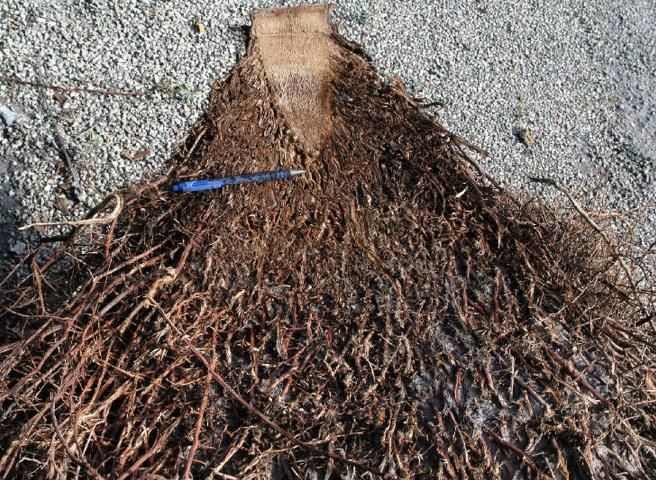
Credit: Timothy K. Broschat
Understanding how palm roots grow and respond to being cut can greatly improve the chances of success when transplanting palms. In addition, other factors—such as rootball size, leaf removal and tying, physiological age of the palm, transplanting season, and planting depth—can also have a significant impact on the success of palm transplants. The purpose of this document is to discuss how these and other factors contribute to palm transplant survival rate.
Transplanting Container-Grown Palms into the Landscape
Container-grown plants often have roots that wrap around the inside of the container. In broadleaf trees, these large, wrapping roots must be cut prior to transplanting, or root distribution patterns and tree stability will be permanently affected. With container-grown palms, however, there is no need to cut such wrapping roots since large numbers of new, adventitious roots arising from the root initiation zone will initially supplement and will ultimately replace those early roots that were confined to the container.
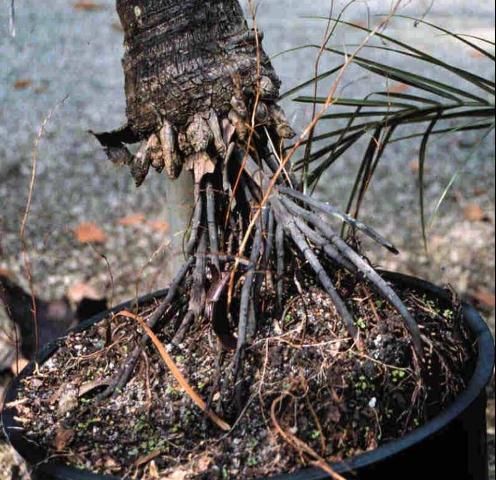
Credit: Timothy K. Broschat
Planting holes for container-grown palms should be roughly twice the diameter of the container in order to facilitate uniform and complete backfilling of the hole. Since the palm may have been growing in the container long enough to allow the potting soil to decompose and settle, base planting depth on the palm root-shoot interface, not on the surface of the container rootball. If extensive settling of the potting soil has occurred, this root-shoot interface may naturally be elevated above the potting-soil surface (Figure 2). Planting such palms at the same level as the top of the rootball will result in a poorly-anchored palm that is susceptible to toppling over (Figure 3). Container-grown palms should always be planted so that the top of the root-shoot interface is about one inch below the surface of the soil.
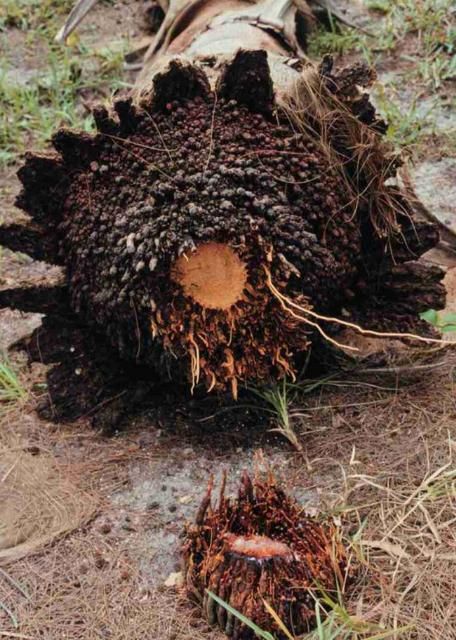
Credit: Timothy K. Broschat
If shallowly planted palms are encountered in the landscape, stabilize the palms by mounding up soil to cover the root-initiation zone. This mound of soil will allow the root initials to continue their growth down into the soil, firmly anchoring the palm.
Fertilization of palms transplanted from containers is critical to successful establishment. Palms growing in Florida landscapes grow best with a relatively low nitrogen (N) content fertilizer (e.g., 8-2-12-4Mg). (For more on this topic, see EDIS Publication ENH1009, Fertilization of Field-grown and Landscape Palms in Florida, https://edis.ifas.ufl.edu/ep261.) By contrast, palms growing in containers have very high N requirements due to microbial demands for N as microbes degrade pine bark and other organic components in the potting soil. (For more on this topic, see EDIS Publication ENH1010, Nutrition and Fertilization of Palms in Containers, https://edis.ifas.ufl.edu/ep262.) When a palm is transplanted to the landscape from a container, most of the palm's root system will remain largely confined to the original organic potting soil for several months following transplanting. As a result, container-grown palms that do not receive high N fertilizers after transplanting are likely to establish slowly and display symptoms of N deficiency during the first six to 12 months following planting. (For more on this topic, see EDIS Publication ENH1016, Nitrogen Deficiency in Palms, https://edis.ifas.ufl.edu/ep268). New research has demonstrated that palms fertilized with a high N fertilizer during the first six months after transplanting from containers established faster than those receiving lower-N, landscape-maintenance fertilizers.
Fertilizers applied at time of transplanting should be top-dressed over the original rootball, and the area of fertilization should extend out 6–12 inches beyond the rootball edge. Subsequent fertilizations can follow recommendations for landscape palm maintenance. (For more on this topic, see EDIS Publication ENH1009, Fertilization of Field-grown and Landscape Palms in Florida, https://edis.ifas.ufl.edu/ep261.)
Treatment of transplanted, container-grown palms with various mycorrhizal or microbial inoculants has been marketed extensively. However, a recent study evaluating four such products on Washingtonia robusta and Syagrus romanzoffiana showed no benefit from any of these inoculants when compared to proper fertilization alone (Broschat and Elliott 2009). Since many of these inoculant products also contain fertilizer, it was concluded that any benefits observed from their use was due to their nutrient content, not due to their microbes.
Palms transplanted from containers will require regular irrigation until they become established (six to eight months) since the well drained potting soil in their original root ball will dry out more rapidly than the surrounding soil. If the palms are to be irrigated by hand, a shallow berm should be constructed just outside of the rootball perimeter to retain water in the rootball area. The frequency of irrigation required will vary with soil type and weather conditions, but irrigation or rainfall events on alternate days are usually adequate for palms during the establishment phase. Once palms become established, irrigation frequency can be reduced and eventually eliminated completely.
Transplanting Field-Grown Palms
Root Regeneration Responses
The question of how a palm responds to having its roots cut is central to palm transplanting success. To answer that question, Broschat and Donselman (1984; 1990b) demonstrated in a series of experiments that different palm species respond differently (Table 1). For example, when roots of Sabal palmetto were cut, virtually all cut roots died back to the trunk and were eventually replaced by massive numbers of new roots originating from the root-initiation zone (Figure 4). As a result of this response, it didn't matter whether roots of a Sabal palmetto were cut close to the trunk or 3 feet away from the trunk.

Credit: Timothy K. Broschat
In the coconut palm, regardless of whether roots were cut close to the trunk or some distance away from the trunk, about half of all the roots that were cut survived, branched, and continued growing. Very few new roots were initiated from the root initiation-zone in response to root cutting in this species.
For most other species of palms, however, root survival strongly correlated with the distance from the trunk that the root was cut; roots cut 3 feet from the trunk survived much better than roots cut 6 inches from the trunk.
The number of new roots produced from the root-initiation zone in response to cutting of roots also varied among palm species. Thus, survival of Sabal palmetto depends solely on initiation of new roots from the root-initiation zone. For coconut and queen palms, however, survival of existing cut roots is critical. For Washingtonia robusta, Phoenix reclinata, and Roystonea regia, survival of existing roots and initiation of new ones is critical.
Rootball Size
The above data can be useful in determining the minimum rootball size expected to result in good transplant success for these species. Based on Table 1 data, we can recommend a minimal rootball size for Sabal palmetto since taking a larger rootball will not improve survival of existing roots. Similarly, the rootball for Cocos nucifera need not be large since survival of existing roots is similar for both short and long root stubs. For Syagrus romazoffiana, 6–12 inches represents the minimum rootball radius from the trunk. For Washingtonia robusta and Roystonea regia, 1–2 feet is the minimum recommended rootball radius. A roobtall radius of 2–3 feet is recommended for Phoenix reclinata. Keep in mind that rootballs are three-dimensional, and rootball depth also contributes to root survival.
Effects of Developmental Age
Landscapers have long observed that juvenile (without visible trunks) Sabal palmetto rarely survive transplanting while older Sabal palmetto specimens with trunks at least 10 feet tall transplant with a high degree of success. This difference in transplanting success among palms that are of the same species, but at a different developmental age is because the root-initiation zone is not developed until a palm develops a trunk. Since no cut roots of Sabal palmetto survive, and juvenile palms have no root-initiation zone to produce replacement roots, the juvenile Sabal palmetto have no chance of surviving the transplant process.
In one experiment, Broschat and Donselman (1990a) found that among 340 juvenile palms of 17 species that had their root systems cut off, not a single new root was produced, and all those palms ultimately died. However, when trunked specimens of two of these species were similarly treated, all of these palms produced new root systems and survived. Thus, for species such as Sabal palmetto and others that depend on the initiation of replacement root systems for transplant survival, only specimens that have a visible trunk should be transplanted from a field or landscape.
Seasonal Effects
Although root growth is more rapid during warm months (Broschat 1998), palm transplant success is also strongly influenced by wet-dry seasonality. Late spring months in South Florida are some of the warmest months, but these months are also the driest.
In the case of Sabal palmetto, which depends solely on water stored within the trunk to survive until a new root system can be produced, transplanting during the warm, dry months in South Florida has been shown to greatly reduce this palm's survival rate. The lower survival rate is because these palms are typically under water stress in the natural environment at that time of year in South Florida, prior to being dug up for transplanting.
For most palms in Florida, planting during the rainy season (June–November) will increase rates of transplant survival. By contrast, in Mediterranean climates, such as California, Pittenger et al. (2005) recommend planting during the warm, but dry months of May to July.
Rooting Hormone Effects
Stimulation of new roots from the root-initiation zone using rooting hormones would be a useful tool for enhancing palm transplant survival. However, Broschat and Donselman (1990a) found that Phoenix roebelenii did not respond to trunk soaks in solutions of IBA (indolebutyric acid).
Root Pruning
Root pruning is a common practice in the production and harvesting of broadleaf trees. However, because of the nature of palm root systems, it usually is not necessary to prune palm roots. Nonetheless, for valuable, but difficult-to-transplant palm species, such as Bismarckia nobilis, root pruning is often practiced. With this technique, a fraction of the roots are severed just inside the future rootball about four to six weeks prior to digging. This pruning stimulates the production of new roots from the root-initiation zone and allows new root tips to begin growth prior to moving the palm. However, great care must be taken to ensure that new root tips are not recut during the digging process. Some growers dig one-half of the rootball in advance and wrap that side with polypropylene weed-barrier fabric to prevent new roots from growing beyond the intended rootball diameter.
Digging Palms
Palms can be dug by hand or with mechanical tree spades. Prior to digging, the soil should be moistened to help keep the palm's rootball intact. Palms growing in sandy soils will need to have their rootballs wrapped in burlap after digging. Palms that are not to be planted immediately should have their rootballs moistened regularly to prevent drying out.
Effects of Leaf Removal
Since water stress appears to be the primary physiological problem associated with transplanted palms, any practice that reduces water stress in transplanted palms should improve palm survival rates. Typically, one-half to two-thirds of the oldest leaves are removed at the time of digging to facilitate handling and to reduce leaf surface area, from which water loss occurs (Figure 5).

Credit: Timothy K. Broschat
For Sabal palmetto, the species in which few or no roots survive after cutting, Broschat (1991) and Costonis (1995) showed that survival and regrowth rates after transplanting were significantly greater for palms that had all leaves removed at the time of transplanting. In other palm species, however, leaving some or all leaves on the palms resulted in more rapid rooting and canopy regrowth than if all leaves were removed (Broschat 1994; Hodel et al. 2003; 2006).
Preparation for Transport
The leaves remaining on the palm should be tied together to prevent leaf damage and to facilitate handling. Palms with slender trunks should have splints attached to the trunks and leaf bundles to prevent the palms from snapping during handling. Use of splints is also recommended for palm species with large, heavy crowns, but soft wood, such as Phoenix canariensis.
Palms should be lifted only by means of nylon slings wrapped around the trunk (Figure 6). Never attach chain, cables, or ropes directly to palm trunks; such practices can result in injury and possibly fatal diseases, such as Thielaviopsis trunk. (For more on that topic, see EDIS Publication PP219, Thielaviopsis Trunk Rot of Palm, https://edis.ifas.ufl.edu/pp143.)
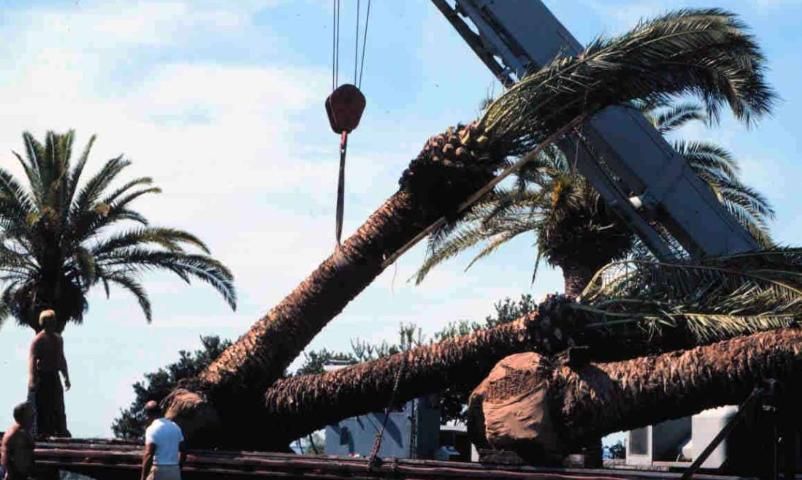
Credit: Timothy K. Broschat
During transport on truck or trailer, palms should be well supported along their entire length (Figure 7). Unsupported crowns may crack or damage the bud, resulting in reduced survival rates.
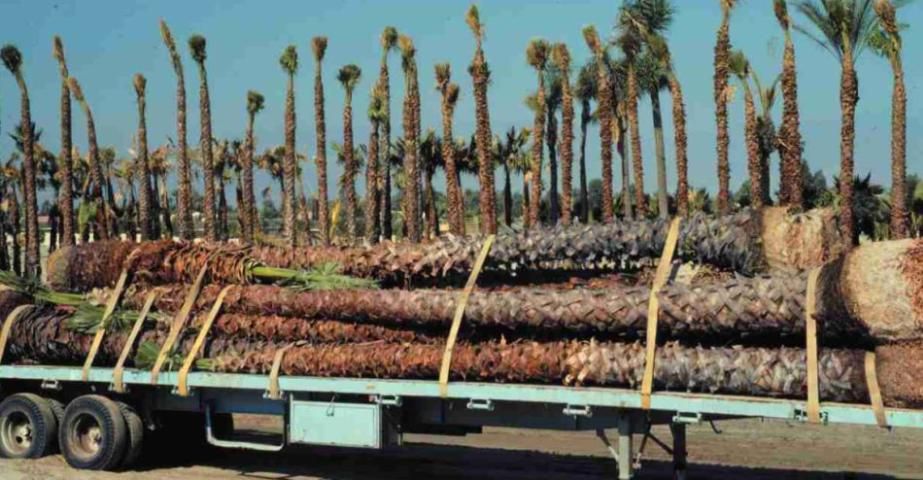
Credit: Timothy K. Broschat
Site Preparation
Palms should be planted as soon as possible into their final site. However, if palms must be held for some time before they can be planted, they should be "healed-in" in an upright position with the leaf bundles untied until they can be moved to their permanent site. For shorter time periods, simply storing the palms upright and keeping the rootballs moist may be adequate.
Palms should not be planted into sites with high water tables or poor drainage (Figure 8). Such sites can be planted if mounds or berms are used to build up the area to be planted. Clay hardpans, where they occur, should be drilled through to improve drainage. Planting holes should be roughly twice the diameter of the rootball to facilitate backfilling, but need not be any deeper than the rootball.
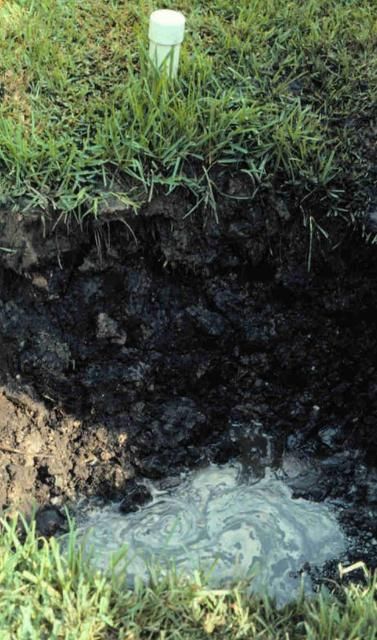
Credit: Timothy K. Broschat
Planting
Field-grown palms should always be transplanted to the same depth at which they were previously growing. Palms transplanted deeper have been shown to have increased incidence of chronic nutritional deficiencies, such as iron or manganese deficiencies (Broschat 1995). (For more on these nutritional deficiencies in palms, see EDIS Publication ENH1013, Iron Deficiency in Palms, https://edis.ifas.ufl.edu/ep265, and EDIS Publication ENH1015, Manganese Deficiency in Palms, https://edis.ifas.ufl.edu/ep267.) Such palms are also often stunted and grow poorly, compared to properly planted palms (Figure 9). In addition to nutrient deficiencies, deeply planted palms may also suffer from water stress. As a result of these palms' weakened condition, they may attract secondary pests, such as palm weevils (Rhychophorus sp.). Palms that are planted too deeply may also develop secondary root rots due to the suffocation of deeply buried roots. Deeply planted palms may linger in a state of poor health for many years, or they may die at any time.
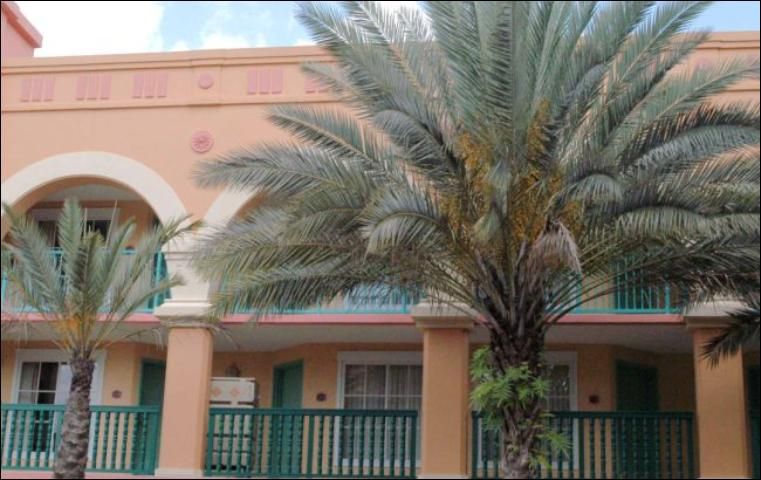
Credit: Timothy K. Broschat
There is no scientific evidence that amending backfill with organic matter or other materials is beneficial to palms (Hodel et al. 2006). While adding commercial preparations of mycorrhizae and other beneficial microbes to the backfill is a common practice, Broschat and Elliott (2009) concluded that the only benefit derived from these products was due to the fertilizers that were added to some of the products and not to the microbes themselves.
When backfilling palm planting holes, be sure to wash soil down into all voids to eliminate air pockets (Figure 10). A shallow berm should be constructed around the perimeter of the rootball of the newly transplanted palm to retain water in the rootball area during irrigation (Figure 11). The soil around the rootball should be kept uniformly moist, but never saturated during the first four to six months following transplanting. After that time, irrigation frequency can be reduced or eliminated altogether if adequate rainfall is received. Research has shown no benefit to irrigating the crown of the palm versus soil application of water (Broschat 1994).
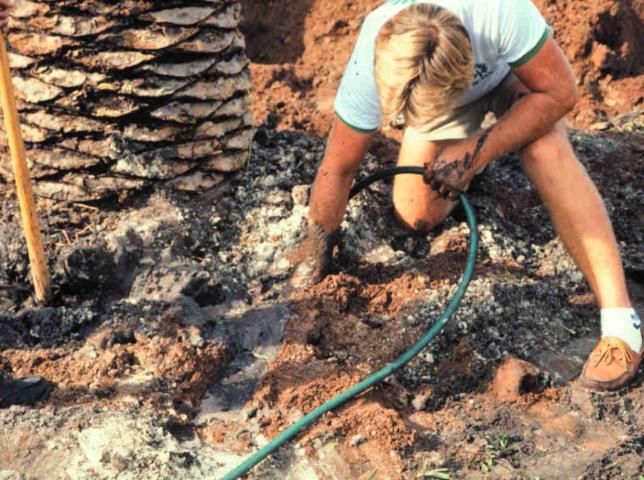
Credit: Timothy K. Broschat

Credit: Timothy K. Broschat
Leaves should be untied as soon as the palm is installed. Research in Florida and California has shown that keeping the leaves tied up provides no benefit to the palm, but can provide a favorable environment for plant diseases, such as Gliocladium blight (pink rot) (Broschat 1994; Hodel et al. 2003; 2006).
Support
Tall palms should be provided with supports to prevent toppling over in high winds and to provide a stable rootball-soil interface (Broschat and Donselman 1987). Deep planting is not an acceptable alternative to mechanical support. Support timbers must not be nailed directly into the trunk since any wounds to a palm trunk are permanent and can allow for entry of pathogens, such as Thielaviopsis. (For more on that topic, see EDIS Publication PP219, Thielaviopsis Trunk Rot of Palm, https://edis.ifas.ufl.edu/pp143.)
An excellent method for providing support to a tall palm during establishment is to strap short lengths of 2 x 4-inch lumber to the trunk and nail the support timbers into these pieces (Figure 12). Supports should be left in place for about a year.
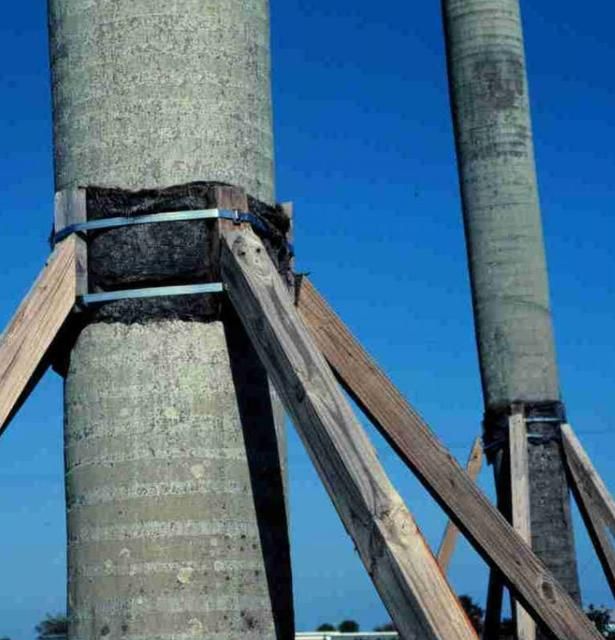
Credit: Timothy K. Broschat
Post-Transplant Care
Container-grown palms have been shown to benefit greatly from high N fertilization at planting time since the bulk of their root system is confined to the N-demanding potting soil in which they were produced. For their first 6–12 months, these palms should be fertilized with high N controlled release fertilizers like those used for container productionTransplanted field-grown palms have also been shown to benefit from light fertilization with an 8-2-12-4Mg controlled-release fertilizer at planting even though they have lost the majority of their root systems. Regular maintenance fertilization with this material can begin as soon as new shoot growth is observed (For more on this topic, see EDIS Publication ENH1009, Fertilization of Field-grown and Landscape Palms in Florida, https://edis.ifas.ufl.edu/EP261.)
References
Broschat, T.K. 1991. Effects of leaf removal on survival of transplanted sabal palms. J. Arboriculture 17:32–33.
Broschat, T.K. 1994. Effects of leaf removal, leaf tying, and overhead irrigation on transplanted pygmy date palms. J. Arboriculture 20:210–213.
Broschat, T.K. 1995. Planting depth affects survival, root growth, and nutrient content of transplanted pygmy date palms. HortScience 30:1031–1032.
Broschat, T.K. 1998. Root and shoot growth patterns in four palm species and their relationship to air and soil temperature. HortScience 33:995–998.
Broschat, T.K. and H. Donselman. 1984. Root regeneration in transplanted palms. Principes 28:90–91.
Broschat, T.K. and H. Donselman. 1987. Factors affecting palm transplanting success. Proc. Fla. St. Hort. Soc. 100:396–397.
Broschat, T.K. and H. Donselman. 1990a. IBA, plant maturity, and regeneration of palm root systems. HortScience 25:232.
Broschat, T.K. and H. Donselman. 1990b. Regeneration of severed roots in Washingtonia robusta and Phoenix reclinata. Principes 34:96–97.
Broschat, T.K. and M.L. Elliott. 2009. Effects of pre-plant fertilization and microbial inoculants on growth of Mexican fan palm and queen palm. HortTechnology 19:324–330.
Broschat, T.K. and K.A. Moore. 2010. Effects of fertilization on the growth and quality of container-grown areca palms and Chinese hibiscus during establishment in the landscape. HortTechnology 20:389–394.
Broschat, T.K. and K.A. Moore. 2012. Fertilization rate and placement effects on areca palms transplanted from containers or a field nursery. Arboriculture and Urban Forestry 38:146–150.
Costonis, A.C. 1995. Factors affecting the survival of transplanted sabal palms. J. Arboriculture. 21:98–102.
Hodel, D.R., J. Downer, and D.R. Pittinger. 2006. Effect of leaf removal and tie-up on transplanted large Mexican fan palms (Washingtonia robusta). Palms 50:76–81.
Hodel, D.R., A.J. Downer, D.R. Pittinger, and P.J. Beaudoin. 2006. Effect of amended backfill soils when planting five species of palm. HortTechnology 16:457–460.
Hodel, D.R., D.R. Pittinger, and A.J. Downer. 2003. Effects of leaf removal and tie-up on juvenile transplanted Canary Island date palm (Phoenix canariensis) and queen palm (Syagrus romanzoffiana). Palms 47:177–184.
Pittenger, D.R., D.R. Hodel, and A.J. Downer. 2005. Transplanting specimen palms: a review of common practices and research-based information. HortTechnology 15:128–132.